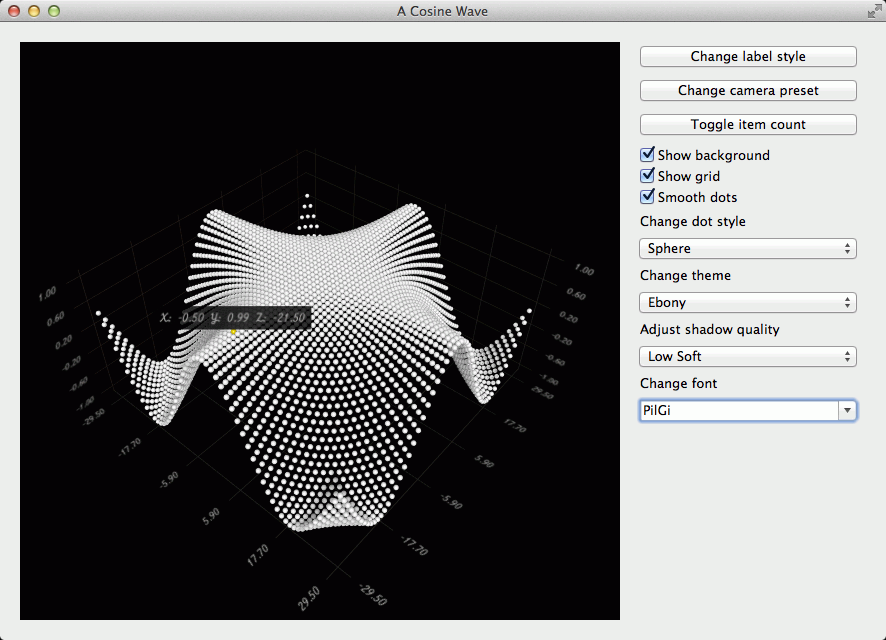Scatter Example¶
Using Q3DScatter in a widget application.
The scatter example shows how to make a simple 3D scatter graph using Q3DScatter and combining the use of widgets for adjusting several adjustable qualities. The example shows how to:
Create an application with
Q3DScatterand some widgetsUse
QScatterDataProxyto set data to the graphAdjust some graph properties using widget controls
For instructions about how to interact with the graph, see this page .
Running the Example¶
To run the example from Qt Creator , open the Welcome mode and select the example from Examples. For more information, visit Building and Running an Example.
Creating the Application¶
First, in main.cpp, we create a QApplication , instantiate Q3DScatter , and a window container for it:
app = QApplication([]) graph = Q3DScatter() container = QWidget.createWindowContainer(graph)
The call to createWindowContainer is required, as all data visualization graph classes ( Q3DBars , Q3DScatter , and Q3DSurface ) inherit QWindow . Any class inheriting QWindow cannot be used as a widget any other way.
Then we’ll create horizontal and vertical layouts. We’ll add the graph and the vertical layout into the horizontal one:
widget = QWidget() hLayout = QHBoxLayout(widget) vLayout = QVBoxLayout() hLayout.addWidget(container, 1) hLayout.addLayout(vLayout)
We’re not using the vertical layout for anything yet, but we’ll get back to it in Using widgets to control the graph
Next, let’s create another class to handle the data addition and other interaction with the graph. Let’s call it ScatterDataModifier (See Setting up the graph and Adding data to the graph for details):
modifier = ScatterDataModifier(graph)
The application main is done. We can show the graph and start the event loop:
widget.show() sys.exit(app.exec())
Setting up the Graph¶
Let’s set up some visual qualities for the graph in the constructor of the ScatterDataModifier class we instantiated in the application main:
m_graph.activeTheme().setType(Q3DTheme.ThemeEbony) font = m_graph.activeTheme().font() font.setPointSize(m_fontSize) m_graph.activeTheme().setFont(font) m_graph.setShadowQuality(QAbstract3DGraph.ShadowQualitySoftLow) m_graph.scene().activeCamera().setCameraPreset(Q3DCamera.CameraPresetFront)
None of these are required, but are used to override graph defaults. You can try how it looks with the preset defaults by commenting the block above out.
Finally we create a QScatterDataProxy and the associated QScatter3DSeries . We set custom label format and mesh smoothing for the series and add it to the graph:
proxy = QScatterDataProxy() series = QScatter3DSeries(proxy) series.setItemLabelFormat(QStringLiteral("@xTitle: @xLabel @yTitle: @yLabel @zTitle: @zLabel")) series.setMeshSmooth(m_smooth) m_graph.addSeries(series)
That concludes setting up the graph.
Adding Data to the Graph¶
The last thing we do in the ScatterDataModifier constructor is to add data to the graph:
addData()
The actual data addition is done in addData() method. First we configure the axes:
m_graph.axisX().setTitle("X") m_graph.axisY().setTitle("Y") m_graph.axisZ().setTitle("Z")
This could have been done in the constructor of ScatterDataModifier, but we added it here to keep the constructor simpler and the axes configuration near the data.
Next we create a data array:
dataArray = QScatterDataArray() dataArray.resize(m_itemCount) ptrToDataArray = dataArray.first()
and populate it:
limit = qSqrt(m_itemCount) / 2.0f for i in range(-limit, limit): for j in range(-limit, limit): ptrToDataArray.setPosition(QVector3D(i + 0.5f, qCos(qDegreesToRadians((i * j) / m_curveDivider)), j + 0.5f)) ptrToDataArray = ptrToDataArray + 1
Finally we tell the proxy to start using the data we gave it:
m_graph.seriesList().at(0).dataProxy().resetArray(dataArray)
Now our graph has the data and is ready to be used. There isn’t much interaction yet, though, so let’s continue by adding some widgets to play with.
Using Widgets to Control the Graph¶
First, back in the application main, we’ll create some widgets:
themeList = QComboBox(widget) themeList.addItem(QStringLiteral("Qt")) themeList.addItem(QStringLiteral("Primary Colors")) themeList.addItem(QStringLiteral("Digia")) themeList.addItem(QStringLiteral("Stone Moss")) themeList.addItem(QStringLiteral("Army Blue")) themeList.addItem(QStringLiteral("Retro")) themeList.addItem(QStringLiteral("Ebony")) themeList.addItem(QStringLiteral("Isabelle")) themeList.setCurrentIndex(6) labelButton = QPushButton(widget) labelButton.setText(QStringLiteral("Change label style")) smoothCheckBox = QCheckBox(widget) smoothCheckBox.setText(QStringLiteral("Smooth dots")) smoothCheckBox.setChecked(True) itemStyleList = QComboBox(widget) itemStyleList.addItem(QStringLiteral("Sphere"), int(QAbstract3DSeries.MeshSphere)) itemStyleList.addItem(QStringLiteral("Cube"), int(QAbstract3DSeries.MeshCube)) itemStyleList.addItem(QStringLiteral("Minimal"), int(QAbstract3DSeries.MeshMinimal)) itemStyleList.addItem(QStringLiteral("Point"), int(QAbstract3DSeries.MeshPoint)) itemStyleList.setCurrentIndex(0) cameraButton = QPushButton(widget) cameraButton.setText(QStringLiteral("Change camera preset")) itemCountButton = QPushButton(widget) itemCountButton.setText(QStringLiteral("Toggle item count")) backgroundCheckBox = QCheckBox(widget) backgroundCheckBox.setText(QStringLiteral("Show background")) backgroundCheckBox.setChecked(True) gridCheckBox = QCheckBox(widget) gridCheckBox.setText(QStringLiteral("Show grid")) gridCheckBox.setChecked(True) shadowQuality = QComboBox(widget) shadowQuality.addItem(QStringLiteral("None")) shadowQuality.addItem(QStringLiteral("Low")) shadowQuality.addItem(QStringLiteral("Medium")) shadowQuality.addItem(QStringLiteral("High")) shadowQuality.addItem(QStringLiteral("Low Soft")) shadowQuality.addItem(QStringLiteral("Medium Soft")) shadowQuality.addItem(QStringLiteral("High Soft")) shadowQuality.setCurrentIndex(4) fontList = QFontComboBox(widget) fontList.setCurrentFont(QFont("Arial"))
And add them to the vertical layout we created earlier:
vLayout.addWidget(labelButton, 0, Qt.AlignTop) vLayout.addWidget(cameraButton, 0, Qt.AlignTop) vLayout.addWidget(itemCountButton, 0, Qt.AlignTop) vLayout.addWidget(backgroundCheckBox) vLayout.addWidget(gridCheckBox) vLayout.addWidget(smoothCheckBox, 0, Qt.AlignTop) vLayout.addWidget(QLabel(QStringLiteral("Change dot style"))) vLayout.addWidget(itemStyleList) vLayout.addWidget(QLabel(QStringLiteral("Change theme"))) vLayout.addWidget(themeList) vLayout.addWidget(QLabel(QStringLiteral("Adjust shadow quality"))) vLayout.addWidget(shadowQuality) vLayout.addWidget(QLabel(QStringLiteral("Change font"))) vLayout.addWidget(fontList, 1, Qt.AlignTop)
Now, let’s connect them to methods in ScatterDataModifier:
QObject.connect(cameraButton, QPushButton.clicked, modifier, ScatterDataModifier::changePresetCamera) QObject.connect(labelButton, QPushButton.clicked, modifier, ScatterDataModifier::changeLabelStyle) QObject.connect(itemCountButton, QPushButton.clicked, modifier, ScatterDataModifier::toggleItemCount) QObject.connect(backgroundCheckBox, QCheckBox.stateChanged, modifier, ScatterDataModifier::setBackgroundEnabled) QObject.connect(gridCheckBox, QCheckBox.stateChanged, modifier, ScatterDataModifier::setGridEnabled) QObject.connect(smoothCheckBox, QCheckBox.stateChanged, modifier, ScatterDataModifier::setSmoothDots) QObject.connect(modifier, ScatterDataModifier.backgroundEnabledChanged, backgroundCheckBox, QCheckBox.setChecked) QObject.connect(modifier, ScatterDataModifier.gridEnabledChanged, gridCheckBox, QCheckBox.setChecked) QObject.connect(itemStyleList, SIGNAL(currentIndexChanged(int)), modifier, SLOT(changeStyle(int))) QObject.connect(themeList, SIGNAL(currentIndexChanged(int)), modifier, SLOT(changeTheme(int))) QObject.connect(shadowQuality, SIGNAL(currentIndexChanged(int)), modifier, SLOT(changeShadowQuality(int))) QObject.connect(modifier, ScatterDataModifier.shadowQualityChanged, shadowQuality, QComboBox.setCurrentIndex) QObject.connect(graph, Q3DScatter.shadowQualityChanged, modifier, ScatterDataModifier::shadowQualityUpdatedByVisual) QObject.connect(fontList, QFontComboBox.currentFontChanged, modifier, ScatterDataModifier::changeFont) QObject.connect(modifier, ScatterDataModifier.fontChanged, fontList, QFontComboBox.setCurrentFont)
Here are the methods in ScatterDataModifier the signals were connected to:
def changeStyle(self, style): comboBox = QComboBox (sender()) if (comboBox) { m_style = QAbstract3DSeries.Mesh(comboBox.itemData(style).toInt()) if (m_graph.seriesList().size()) m_graph.seriesList().at(0).setMesh(m_style) def setSmoothDots(self, smooth): m_smooth = bool(smooth) series = m_graph.seriesList().at(0) series.setMeshSmooth(m_smooth) def changeTheme(self, theme): currentTheme = m_graph.activeTheme() currentTheme.setType(Q3DTheme.Theme(theme)) backgroundEnabledChanged.emit(currentTheme.isBackgroundEnabled()) gridEnabledChanged.emit(currentTheme.isGridEnabled()) fontChanged.emit(currentTheme.font()) def changePresetCamera(self): preset = Q3DCamera.CameraPresetFrontLow() m_graph.scene().activeCamera().setCameraPreset((Q3DCamera.CameraPreset)preset) if (++preset > Q3DCamera.CameraPresetDirectlyBelow) preset = Q3DCamera.CameraPresetFrontLow def changeLabelStyle(self): m_graph.activeTheme().setLabelBackgroundEnabled(not m_graph.activeTheme().isLabelBackgroundEnabled()) def changeFont(self, font): newFont = font newFont.setPointSizeF(m_fontSize) m_graph.activeTheme().setFont(newFont) def shadowQualityUpdatedByVisual(self, sq): quality = int(sq) shadowQualityChanged.emit(quality) def changeShadowQuality(self, quality): QAbstract3DGraph.ShadowQuality sq = QAbstract3DGraph.ShadowQuality(quality) m_graph.setShadowQuality(sq) def setBackgroundEnabled(self, enabled): m_graph.activeTheme().setBackgroundEnabled((bool)enabled) def setGridEnabled(self, enabled): m_graph.activeTheme().setGridEnabled((bool)enabled)
And so we have an application in which we can control:
Label style
Camera preset
Background visibility
Grid visibility
Dot shading smoothness
Dot style
Theme
Shadow quality
Label font
Example Contents¶
© 2022 The Qt Company Ltd. Documentation contributions included herein are the copyrights of their respective owners. The documentation provided herein is licensed under the terms of the GNU Free Documentation License version 1.3 as published by the Free Software Foundation. Qt and respective logos are trademarks of The Qt Company Ltd. in Finland and/or other countries worldwide. All other trademarks are property of their respective owners.

